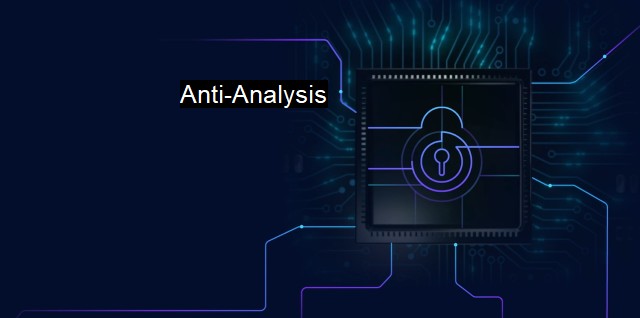What are Anti-Analysis?
Navigating the Threats of Anti-Analysis in Cybersecurity: Understanding Malware Development Attack Stages and Mitigating Emerging Risks
"Anti-analysis" is an increasingly prevalent topic within the field of cybersecurity and antivirus research. As digital technologies progress, malicious hackers and cybercriminals equip themselves with more sophisticated methods to penetrate individuals' and organizations' data and vital systems. One such approach is called "anti-analysis", a means used by attackers to evade detection from cybersecurity measures."Anti-analysis" is a technique wherein malware tries to detect and evade automated systems that could analyze and identify it. The primary motive is to prevent cybersecurity experts or systems from understanding the infection and coming up with defensive measures. The mechanism involves the use of obfuscation, packing, polymorphism, time bombs, rootkits, and more sophisticated methods, all designed to evade simple signature-based detection. This technique makes it challenging for antivirus programs to detect such ruthless attacks striving to penetrate system structures. Also, it offers a cover for attackers where they can comfortably prolong their attacks while remaining unexposed.
Understanding anti-analysis tactics requires a closer examination of their commonly used approaches. Obfuscation is a technique used to transform malware into a form that is complicated to decipher without changing its effect. It involves the use of false flags, useless instructions, and code restructuring, among others, to mislead code analysis and prevent pattern recognition.
Packing, on the other hand, is used to compress or encrypt malware's binary code, thereby presenting a different signature that makes detection difficult. Dynamic unpacking of the coded malware further adds to an antivirus's problems as the unpacking only occurs at runtime, making static analysis ineffective.
In addition to these aspects, malware developers use polymorphic and metamorphic codes, which allow malware to continuously change its code to prevent the creation of a precise signature. It enables the malware to reproduce with altered forms effectively, keeping the signature-based malware detection techniques at bay.
Another considerable anti-analysis technique involves the usage of time bombs. In this approach, malware detonates after meeting certain conditions or after a set time. Since the malware's signature often remains dormant and undetectable until its activation, this technique allows attackers to bypass threat detection models that do not engage in behavior-based analysis.
Rootkits, another class of anti-analysis malware, can subtly integrate themselves into the operating system at a kernel or user level. They hide their existence and activities, going as far as concealing related processes' information, making its detection by ordinary security measures difficult.
More advanced techniques include the use of virtual machine detection, which checks if the malware runs in a virtual environment commonly used for analysis, and sandbox detection, programmed to behave benignly when executed in a controlled environment, making analysis misleading.
Given the increasing complexity and evolution of anti-analysis techniques, the cybersecurity field faces enormous challenges. Growingly, there's a need to develop advanced and proactive security measures for effective detection and remediation of such innovative threats. Antivirus measures should thus incorporate behavior-based detection methods, simulate realistic environmental conditions for catching out sandbox detectors, and employ artificial intelligence and machine learning for an adaptive approach that quickly learns and adjusts for identifying and handling novel anti-analysis methods.
The field of "anti-analysis" is highly dynamic and ever-changing, with the sophistication of current methods posing significant challenges to conventional antivirus approaches. In the grand scheme of dealing with such challenges, thorough understanding, research, and advanced tools form the basis for the required defenses against these potential cyber assaults. With adequate efforts from both cybersecurity specialists and developers, there's hope to progressively achieve sturdier strategies designed to withstand these increasingly robust anti-analysis techniques.

Anti-Analysis FAQs
What is anti-analysis in cybersecurity?
Anti-analysis is a technique used by malicious actors to evade detection by antivirus software and other security measures. It involves using various obfuscation and encryption techniques to make a piece of malware difficult to analyze and understand.Why do cybercriminals use anti-analysis techniques?
Cybercriminals use anti-analysis techniques to evade detection and prolong the life of their malware. By making it difficult for security experts to analyze and understand their code, they can keep their malware under the radar and continue to infect new systems.What are some common anti-analysis techniques used by cybercriminals?
Common anti-analysis techniques include packing, obfuscation, encryption, and virtualization. Packing involves compressing the malware to make it harder to detect, while obfuscation involves modifying the code to make it more difficult to analyze. Encryption involves encrypting the code or embedding it within another file, and virtualization involves running the malware in a virtual environment to evade detection.How can organizations defend against anti-analysis techniques?
Organizations can defend against anti-analysis techniques by using a multi-layered approach to security. This includes using up-to-date antivirus software, applying regular security patches, and implementing access controls and other security measures. Additionally, security experts can use sandboxing and other advanced techniques to analyze and understand malware, even if it has anti-analysis features.Related Topics
Anti-debugging techniques fileless malware rootkits packers and crypters obfuscation techniques
| | A | | | B | | | C | | | D | | | E | | | F | | | G | | | H | | | I | | | J | | | K | | | L | | | M | |
| | N | | | O | | | P | | | Q | | | R | | | S | | | T | | | U | | | V | | | W | | | X | | | Y | | | Z | |
| | 1 | | | 2 | | | 3 | | | 4 | | | 7 | | | 8 | | |||||||